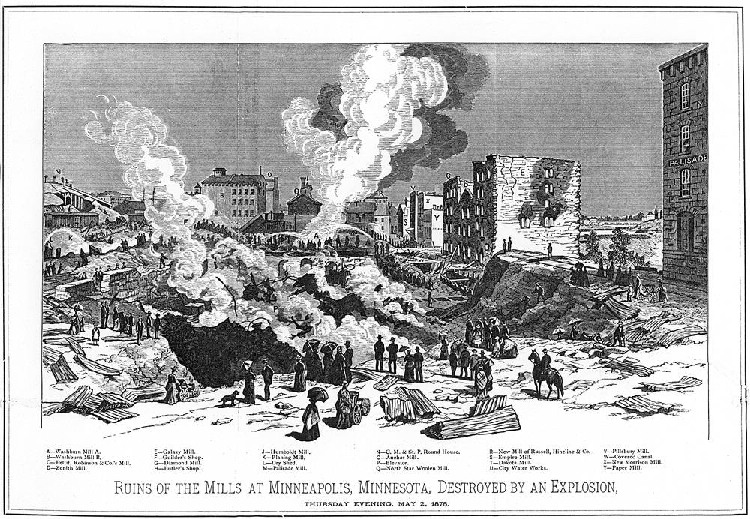 |
Minneapolis Pioneers and Soldiers Memorial Cemetery History Page Alley Article |
| Home | Burial Search | Friends | History | Photo Gallery | Visitor Information |
| Alley Articles |
|
This article originally appeared in the Phillips community's Alley Newspaper, March 2005.
On May 2, 1878, at 7:10 p.m., a spark ignited flour dust in the Washburn A Mill. The explosion that followed blew the mill’s concrete roof several hundred feet in the air and leveled the seven and a-half story limestone building. The nearby Humboldt and Diamond Mills also were flattened by the explosion, and one third of the city’s business district was destroyed by the fire. The explosion broke windows as far away as Summit Avenue in St. Paul, and limestone blocks landed in yards eight blocks from the milling district. People from Minneapolis and St. Paul poured into the streets. Many were convinced that the city had been struck by an earthquake; others believed that the world had ended. When it became clear what had happened, they rushed to the milling district to see the damage and to find out what had happened to the men inside. All of the fourteen men in the Washburn A Mill at the time of the explosion died, as did four men working in neighboring mills. Two of the men killed in the Washburn A Mill explosion are buried in Minneapolis Pioneers and Soldiers Cemetery. August Smith, a miller, and Ole P. Schei, a laborer, were among the workers who had just started the evening shift at the mill. Like most of the other men killed in the explosion, they were family men. Smith and Schei were both married; each had one child. Both were Norwegian immigrants. The Minneapolis City Council appointed a committee to assess the financial condition of the surviving family members. It determined that Smith’s family was better off than most because he had a $1,000 insurance policy that would place his widow “beyond the reach of want.” Mrs. Schei was left in “fair circumstances” because the family owned a home at 1808 2-1/2 Street. For that reason the committee believed that she would “need but little, if any assistance.” The funerals of the two men took place on May 12th. August Smith’s was the more elaborate of the two. He was a member of the International Order of Odd Fellows and the Sons of Hermann, a fraternal organization. Two bands accompanied “the long and solemn procession” down Washington Avenue to Smith’s home, where the service was conducted, and from there accompanied his hearse to the cemetery. Schei’s funeral took place at the Scandinavian Church on Washington Avenue and was described as “less ostentatious in character” than Smith’s. Mrs. Schei’s sorrows did not end with the death of her husband. Their only child, a daughter, died on November 7, 1878, from croup. She was one year, seven months and 19 days old. The baby is buried with her father. The Washburn A Mill was reconstructed in 1879, and in 1885, a monument to the 18 workers killed in the explosion was erected in Lakewood Cemetery. They both bear the same unintentionally ironic inscription: “Labor wide as the earth has its summit in heaven.”
Next Article -> Asa Clark Brown -- April 2005 |
|
©Friends of the Cemetery, 2005-2008 Contact us at history@friendsofthecemetery.org |
File last updated: Monday May 23, 2005 |
